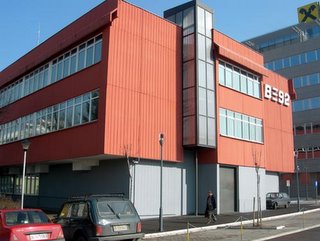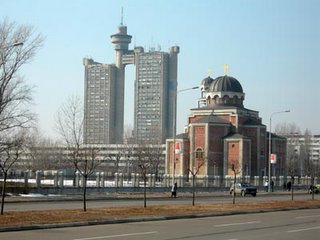 Much of what was west of the Sava River before World War II was swamp land. People from Old Belgrade would cross the river to go to the only attraction, the sajmiste, or fairgrounds. As I mentioned in my earlier posts by e-mail, the Nazis used what is now called Staro Sajmiste (Old Fairgrounds) as a concentration camp and death camp where, according to some people I've talked with, some 40,000 people died. They were Serbians, Gypsies and Jews. There are two monuments there, but apparently there's little other effort to protect the area from falling into ruins or from being demolished in favor of industry and business.
Much of what was west of the Sava River before World War II was swamp land. People from Old Belgrade would cross the river to go to the only attraction, the sajmiste, or fairgrounds. As I mentioned in my earlier posts by e-mail, the Nazis used what is now called Staro Sajmiste (Old Fairgrounds) as a concentration camp and death camp where, according to some people I've talked with, some 40,000 people died. They were Serbians, Gypsies and Jews. There are two monuments there, but apparently there's little other effort to protect the area from falling into ruins or from being demolished in favor of industry and business.After the war, the communist government decided to turn the swamp land beyond Staro Sajmiste into Novi Beograd -- New Belgrade. Television station for which I'm consulting, B-92, is in New Belgrade. The difference between Old and New Belgrade is as stark as you can imagine. The streets are flat and the blocks are square and the buildings -- even those built in the area's early development are sterile and, as my associate here, Boske, says, "Boring!"

One of the oldest looking buildings is the traditional Orthodox Church. They built it, however, about two years ago. Here's an interesting point, because New Belgrade was a communist invention, this church was the very first religious building of any kind in Novi Beograd. In the background, is the Westgate twin towers. One side is business -- the other side is made up of apartments. During the sanctions against Serbia between 1992 and 2000, the middle class pretty much disappeared. People in the office here tell me that the average monthly income was equal to about $5.00. Boske tells the story of how the electricty in the Westgate residential building went out and people had to use the stairs. The people who were near the top of the 29 floors simply couldn't make the trek. The solution? A man o
 n the 11th floor turned his apartment into a grocery store. People above and slightly below him would place their orders. He would buy what they needed and pay workers to carry everything up to his apartment. Then, the people living near the top -- especially the elderly -- would only have to make a short climb up or down for their needed food and supplies.
n the 11th floor turned his apartment into a grocery store. People above and slightly below him would place their orders. He would buy what they needed and pay workers to carry everything up to his apartment. Then, the people living near the top -- especially the elderly -- would only have to make a short climb up or down for their needed food and supplies.There are glimpses of the past that still pass through, however, but if you dropped in from the sky, you'd hardly know New Belgrade from Orange County or Dallas or Phoenix.




No comments:
Post a Comment